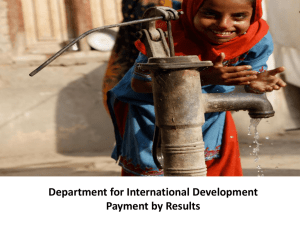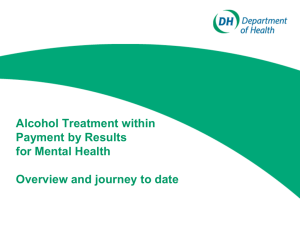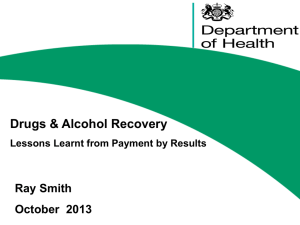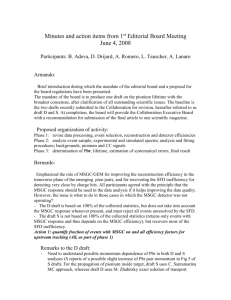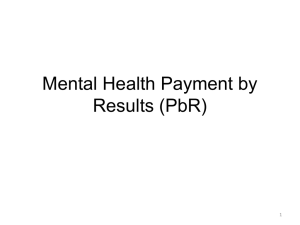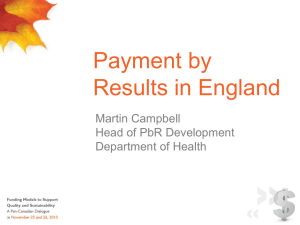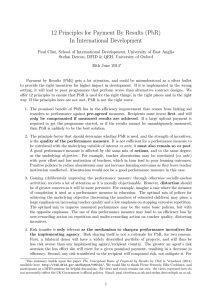PbR - Healthcare for London
advertisement
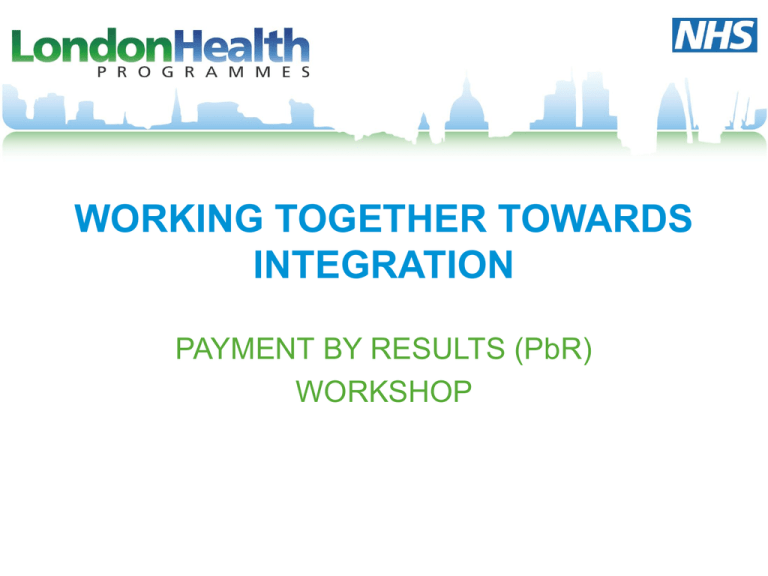
WORKING TOGETHER TOWARDS INTEGRATION PAYMENT BY RESULTS (PbR) WORKSHOP Why Payment By results (PbR)? • Increase the link between payment and quality of care and drive integration of services • Support the expansion of a more transparent rules based funding system • ‘Incentivise best clinical practice and improve outcomes’* * Operating Framework NHS 2012-13 2 Mental Health PbR is different to acute PbR • The currency of Acute PbR is the Healthcare Resource Group (HRG). • HRG uses ICD10 codes and other classification systems . • Mental Health PbR uses Care Clusters instead of HRG. • Mental Health PbR does not use the ICD10. Instead, professionals rate service users using the Mental Health Clustering Tool. 3 Current system • Before PbR most (PCTs) had simple ‘block contracts’– effectively a fixed amount of money for the year ahead. • Many of the risks in the system were carried by providers. i.e. rising activity levels would increase provider costs, without any extra income • Block contracts were generally based on historical patterns of care and reflected local costs of providing care. 4 New system - Care clusters • The Care Clusters are based primarily on the needs and characteristics of a service user • Clinicians allocate a patient to one of 21 care clusters • The clusters are mutually exclusive in that a service user can only be allocated to one cluster at a time. 5 What’s not included in 2012/13 • Improving Access to Psychological Services (IAPT) • Child and Adolescent MH services (CAMHS) • Forensic and secure services • Specialist services (incl. deaf, eating disorder, neuropsychiatry, learning disability, addiction services, alcohol) • MH services under a GP contract (and others) 6 Decision Tree- Care Clusters 7 The Mental Health Clustering tool • The MHCT incorporates items from the Health of the Nations Outcome Scales (HoNOS) and The Summary of Assessments of Risk and Need (SARN). • Part 1 – 12 items HoNOS related to severity of problems • Part 2 – SARN consider problems from a ‘historical perspective’ 8 How does it work? Step 1 Routine screening assessment process scores the patient’s needs using MHCT Step 2 Decision tree - to decide if the presenting needs are A,B,C Then decide which of the next level. This will narrow down the list of possible clusters. Step 3 Look at the grids - which one is the most appropriate red: level of need which must score orange: expected scores yellow : may score 9 Service delivery • Assessments – funded separately and can be classified in three ways a) Assessed, not clustered b) Assessed, clustered c) Assessment ‘service’ • Care pathway – 21 care clusters • Care Transition protocols – move within super cluster or discharge • There is one transition protocol for all MH Providers 10 Different from Wonderland - Clusters as Contract Currency • Commissioners will be paying providers on the basis of x people in cluster 1, x people in cluster 2 and so on. • Payment would be for all elements of care service user receives, both direct (therapies) and indirect (care co-ordination). • Clusters should cover care provided as part of the section 75 arrangements • Person/needs focused as opposed to service focused 11 Strategic Challenges • Timescales • Risk of focus on detail and challenges • Commissioning and governance changes. All of the above will divert attention away from potential of PbR to deliver quality services which focus on ability and reablement and offer choice. 12 Delivering QIPP via PbR If PbR is implemented correctly, PbR will… • Offer a real understanding of how services are configured and delivered • Provide a means to systematically measure quality information that allows data reporting and benchmarking • Inform decisions about commissioning and de–commissioning 13 Using PbR to incentivise quality care If PbR is implemented correctly, PbR will… • Enable payment for a cluster of care with data on the outcomes • Potentially encourage providers and clinicians to innovate with pathway development which delivers better outcomes at the same cost 14 PbR and Personalisation • ‘Personalisation is generally understood to mean a culture in which citizens are able to shape the services they need, with choice and control, so that support fits the way they wish to live their lives’ • ‘The link between personalisation and PbR is vital if the ambition to offer people real choices and achieve more cost effective joined up commissioning and provision is to be realised’* *Getting it together for MH Care: Payment by results, personalisation and whole system working, NDTi, Dec 2011 15 Local Challenges • The quality of data - poor data quality means that trusts will not have a robust currency by April 2012 • Data interpretation • Robust costing mechanism - inaccurate tariff risk destabilising providers and commissioners • Significant variation of funded services between boroughs – price per cluster per trust for 2013-14 16 London programme 2012-13 • London Currencies Development Board (LCDB) - chaired by Wendy Wallace • London Health Programmes (LHP) o Commissioner steering group – chaired by Stuart Saw o Programme approach o Engaged stakeholders 17 Work streams Commissioners • Costing and contracts o Service specs, care clusters o Template for information scheduling and reporting • LA and 3rd sector • Transition to CCGs Providers • Training on transition protocols • Data quality • One price per cluster 18 Work streams cont… Jointly commissioners and providers • Cost per cluster per trust 2013/14 • Develop specs and care clusters • Information and reporting schedules Nationally • Outcome metrics • Expand PbR (IAPT and Forensics in 2013/14) 19 Mental health PbR timeline Commissioning Implementation by providers DH Costing & Implement contracts HoNOS PbR Mandate 2009 2010 2011 2012 April 2012: Introductory year Jan 2009: DH mandates MH PbR 2010: MHCT and transition protocols released April 2013: Go live Feb 2012: 31 Dec 2011: All patients Final guidance released clustered April 2013: •Initial data shared •Contracts signed off Dec 2011: MOU agreed June 2009: Implementation starts 2013 Feb 2012: Training for transition protocols Dec 2011: Joint working initiated April 2012: •Commissioning using PbR

